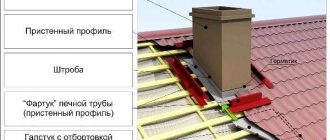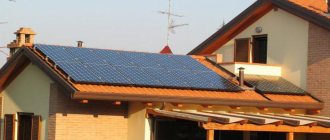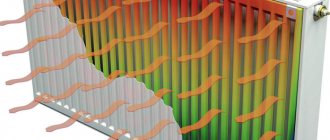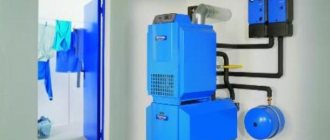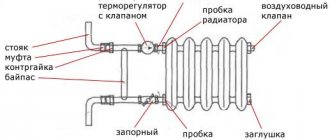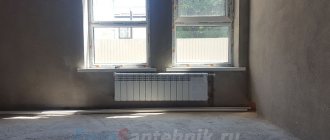When choosing an underfloor convector, there are several important factors that you should pay attention to first. Therefore, we will divide the selection process itself into several stages.
1) CALCULATION OF POWER
The power calculation for floor convectors is based on the following data:
- the area of the room;
ceiling height;
number of storeys;
the presence of other heating devices.
Also, the results of the calculations are affected by the presence or absence of double-glazed windows and the level of thermal insulation of the room as a whole.
The radiated power of this heating element in our climate, on average, is 1 kW per 10 m2. Such power allows even in the most severe frosts to warm up the air in the apartment to 18 - 20 degrees.
If, for example, the area of the room is 20 m2, then the required battery power will be calculated using the following formula:
20: 10 x 1 kW = 2 kW
Thus, it turns out that to heat a room with an area of 20 m2, the total radiated power of the heating devices must be 2 kW.
However, for calculations, it is better to take the minimum indicators in order to provide some power reserve.
When using this formula, by default, it is assumed that the room is not equipped with double-glazed windows and has a single outer wall. But if the room is corner, then 10 m2 will require 1.3 kW of power. In the presence of double-glazed windows, heat loss, on average, is reduced by 25%.
The power of the floor convector also depends on the temperature difference, that is, on the temperature of the heat carrier. The passport attached to the heating device must indicate at what temperature head the radiator will reach the required power. The lower the temperature of the coolant, the more powerful the convector is needed to heat the room.
According to sanitary standards, it is believed that the thermal head should be equal to 70 degrees, but in low-temperature heating systems this figure can be in the range of 30-60 degrees.
You can also find out the required power based on the brand of installed radiators on the manufacturer's website, if, of course, they were installed by the developer.
- 2) SELECTION OF CONVECTOR LENGTH
In order for the floor convector not only to heat the room, but also perform the function of a thermal curtain against the cold coming from the stained-glass window or from the entrance group, and also prevent the stained-glass windows from fogging up, it is necessary that the length of the convector overlaps from 75% to 90% of the window width. That is, if the width of the stained-glass window is 3 m, then the convector should be from 2.25 to 2.75 m, and is located along the central axis of the stained-glass window.
3) SELECTION OF THE CONVECTOR
With the help of the received data (power, length) you can select the floor convector according to the HEATING CAPACITY TABLE,
According to the table, you can select several models of convectors that will suit you, but you should also pay attention to such parameters for a more accurate selection:
- Convector width - how much the convector will protrude into the room;
Convector depth - this parameter deprives the depth of the screed (niche) into which the floor convector will be installed
The presence of a fan - there are two main types of convectors, with natural convection and forced. The first ones (without a fan) are installed in rooms where there is a small area, in bedrooms, or as additional, rather than main heating. With forced convection (with a fan) they are installed as additional or as the main heating in large rooms. They are not recommended for bedrooms.
IF YOU HAVE DIFFICULTIES WITH SELECTING FLOOR CONVECTORS, YOU CAN CONTACT OUR MANAGER FOR HELP.
ALSO OUR SPECIALISTS CAN LEAVE THE OBJECT FOR MEASUREMENTS AND CONSULTATIONS ON THE SELECTION AND INSTALLATION OF FLOOR CONVECTORS.
For heating residential and non-residential premises, a lot of different types of heaters are used. But the most simple, effective and not difficult to install options are. How they work
based on convection - the natural movement of air masses (heated air rises, cools and descends).
The convector device is quite simple. The general diagram of the device is shown in the figure below. Let's consider the main details in more detail.
Heating element
In electric heaters of convection type, heaters of 3 types are installed.
Control unit or thermostat
The heating unit is controlled mechanically or:
The top of the device is closed by a case with openings for air intake. They are placed at the bottom and at the top.
The principle of operation of the electric convector
So how does a convector work? The principle of operation of any type of convector, or electric, is based on the use of the property of air when heated to rise, and when cooled down. Since the device has a built-in heating element
, then when it heats up, the air begins to circulate, passing through the device from bottom to top. The heated air rises to the ceiling, gives off thermal energy to the room, cools and descends. Thus, there is a circulation of air masses in the room.
When a certain temperature in the room is reached, the thermostat or temperature sensor
(depending on the type of control - mechanical or electronic), which turn off the heater. After some time, after the contact plate has cooled down (in the case of mechanical control), the contacts close, and heating continues. With an electronic control module, the temperature sensor will work and turn on the unit only when the room temperature reaches values lower than those that have been programmed.
Calculation of the power of an electric heater
By the area of the room
It should be borne in mind that the calculation of the power of the heating unit by area gives approximate values and requires corrections. But it is simple and can be used for a quick, rough calculation. So, based on the established norms, for a room with one door, one window and a wall height of 2.5 meters, a power of 0.1 kW / h per 1 m 2 of area is required.
For example, if we take a room with an area of 10 m 2 for calculation, then the required power of the unit will be 10 * 0.1 = 1 kW. But there are some factors to consider. When corner room
, the correction factor will be 1.1. The found result should be multiplied by this number. Provided that the room has good thermal insulation, plastic windows (energy-saving) are installed in it, then the result of the calculation should be multiplied by 0.8.
By volume
- calculate the volume of the room (width * length * height);
- the number found must be multiplied by 0.04 (exactly 0.04 kW of heat is needed in order to warm up 1 m 3 of the room);
- using the coefficients, refine the result.
Due to the fact that the room height is also used in the calculation, the power calculation will be more accurate. For example, if the volume of a room is 30 m 3 (area 10 m 2, ceiling height 3 m), then 30 * 0.04 = 1.2 kW. It turns out that this room will require a heater with a capacity slightly higher than that found.
For a more accurate result, the power should be calculated, using the coefficient
... If there is more than one window in the room, then for each next one, 10% is added to the result. This indicator can be reduced if good thermal insulation of the walls (floor in a private house) is made.
As an additional source of heating
If the main heating in severe frosts is not enough, then often an electric convector is used as an additional source of thermal energy. The calculation, in this case, is made as follows:
- when calculating the indicator by area, 30-50 W is required for each square meter;
- when calculated by volume, 0.015-0.02 kW is required per 1 m 3.
Calculation of the power of the convector for the room

When calculating heating convectors by area, it is obvious that the total power of the convector will directly depend not only on the type of room, but also on its area. If you find it difficult to choose the type of your premises, multiply the area by forty. If the room already has heating, it is necessary to reduce the resulting value by about 1.5-2 times.
For apartments with standard ceilings (about 2.5-3 meters), calculations are carried out according to a simplified formula: 100 watts of power are taken per 1 square meter, and 70 watts for use as additional heating equipment.
For the most efficient heating of several rooms, it is advisable to install several small convectors, one in each room. They do not have to be of the same power: more power is taken for the main rooms, and less power for the corner rooms and for the hallway.
New models are equipped with thermostats that turn off the convectors when the room heats up to a certain temperature, so you should not be afraid of excessively active heating - even powerful convectors will turn off as soon as they make your stay in the room comfortable.
Advantages and disadvantages of electric convectors
Positive points:
- Easy to install and use. It is enough to hang it on the wall or set it on the legs, connect the cord to the socket, and the device is ready for use.
- The service life is designed for over 15 years. The unit does not require maintenance, except for periodic dusting.
- The cost of the device is relatively low.
- No human control is required to maintain the required temperature. All this will be done by automation and electronics.
- Lack of noise.
Unless, heaters with mechanical control can emit a soft click when the thermostat is turned on and off. Devices with an electronic module work silently. - The electric convector has a simple operating principle.
- The efficiency of air heaters can reach 95%.
Negative points:
- essential electricity consumption
; - heating large areas using only electric convectors is ineffective; in large rooms they can only be used as additional heating;
- Devices with open (needle-shaped) heating elements may emit an unpleasant odor when switched on from combustible dust deposited on the heater.
It should be remembered that electric heating units are a technique that does not tolerate violations of safety rules. Do not cover or dry laundry on the appliance. The device will overheat, and, at best, protection will work.
The socket must be located on the side of the unit (prohibited from above) at a distance of at least 100 mm from the housing.
Only with the correct operation of the convector can a comfortable and cozy atmosphere in the house be guaranteed.
Requires power calculation - this is a prerequisite for creating an efficient heating system. A device of this type perfectly replaces radiators, while saving space in the room. The convector device, in which most of the heat transfer occurs due to the movement of heated air, gives the effect of faster and more uniform heating.
Example
To help you understand everything, we will give a small example. For example, we need a convector for heating 10 m², there is a window and a ceiling (4 m²). Applying these indicators in our formula, we get:
40x4x10 = 1.6 kilowatts
In this case, the maximum power for such a room will be 2 kilowatts.
Note! We also note that the convector should be located directly under the window so that the cool air coming from the street heats up immediately and does not lead to a decrease in the temperature in the room.
Now let's talk about the case if the convector was installed as an auxiliary heating source. Here, instead of 40, you need to insert 25-35 watts, depending on the volume of the room. The larger the room, the higher the indicator should be used. Let's say our area is 20 m², and the ceiling height is 3 m. We make simple calculations:
The principle of calculating the thermal power of heating devices
The principle of calculating the need for heating devices is the same for radiators and convectors. If we are talking about a room with a standard ceiling height of 2.7 to 3.0 m, then maintaining a comfortable temperature in the range of 19 - 22 C is ensured when 100 watts of heat are supplied per 1 sq. M.
The difference between convector and radiator heating is only in the principle of heat transfer, and the energy requirement of the room for heating remains the same. When calculating, you can resort to a complex complex methodology that is used by specialists in the field of design. It takes into account a large number of factors, therefore it is used for large objects, where the total amount of losses in all apartments and premises adds up to large amounts.
Calculator for the exact calculation of the number of heating radiator sections
A simple calculation does not take into account many factors. The result is curved data. Then some rooms remain cold, others too hot. The temperature can be controlled with shut-off valves, but it is better to calculate everything accurately in advance in order to use the right amount of materials.
Reducing and increasing thermal coefficients are used for accurate calculation. First you should pay attention to the windows. For single glazing, a factor of 1.7 is used. No factor is needed for double windows. For triples, the indicator is 0.85.
If the windows are single, and there is no thermal insulation, then the heat loss will be quite large.
The calculations take into account the ratio of the area of floors and windows. The ideal ratio is 30%. Then apply coefficient 1. When the ratio is increased by 10%, the coefficient is increased by 0.1.
Coefficients for different ceiling heights:
- If the ceiling is below 2.7 m, the coefficient is not needed;
- For indicators from 2.7 to 3.5 m, a coefficient of 1.1 is used;
- When the height is 3.5-4.5m, a factor of 1.2 will be required.
In the presence of attics or upper floors, it also applies certain coefficients. With a warm attic, an indicator of 0.9 is used, a living room - 0.8. For unheated attics take 1.
Simple calculation using coefficients
If you decide to resort to a simple calculation of the power of a heating convector for a private house, then you can use two main methods - in terms of volume for high rooms and in terms of area for standard ones. At the same time, it is possible to include in the formula the main correction factors reflecting the heat loss of walls and windows.
Basic calculation data for the Breeze convector model produced by KZTO:
- passport power of the product, depending on the size - the longer the length of the device, the greater its heat transfer;
- real dimensions of the device in height, depth and length;
- area of the room;
- additional correction factors, taking into account the characteristics of the room - the construction of the walls and glazing.
For a more accurate calculation, we will introduce correction factors - in the example we considered a room with one outer brick wall and single-layer glazing in the form of a window. If the room is corner, then the demand will increase by about 10% (coefficient 1.1), if the glazing is triple, then we introduce a coefficient of 0.8 - it will show a decrease in heat demand.
In the simplest version, heating a room with an area of 20 sq. M.will require the installation of convectors with a total capacity of 2.0 kW, a corner room - 2.2 kW, with good insulation and high-quality double-glazed windows - about 1.7 kW. The calculation was made for a room up to 3.0 m high.
Calculation of the required power of the convector
For a detailed calculation of the thermal power, professional methods are used. They are based on the calculation of the amount of heat losses through the enclosing structures and the corresponding compensation of their heat output of heating. The techniques are implemented both manually and in a program format.
To calculate the heat output of convectors, the method of aggregated calculation is also used (if you do not want to contact the designers). The power of the convectors can be calculated by the size of the heated area and the volume of the room.
The generalized standard for heating a built-in room with one outer wall, a ceiling height of up to 2.7 meters and a single glazed window is 100 W of heat per square meter of heated area.
In the case of an angular arrangement of the room and the presence of two external walls, a correction factor of 1.1 is applied, which increases the calculated heat output by 10%. With high-quality thermal insulation, triple glazing, the design power is multiplied by a factor of 0.8.
Thus, the calculation of the heat output of the convector is calculated based on the area of the room - to heat a room with an area of 20 square meters with standard heat losses, a device with a power of at least 2.0 kW is required. With an angular arrangement of this room, the power will be from 2.2 kW. In a high-quality insulated room of equal area, you can install a convector with a capacity of about 1.6 - 1.7 kW. These calculations are correct for rooms with a ceiling height of up to 2.7 meters.
In rooms with a higher ceiling height, the volume calculation method is used. The volume of the room is calculated (the product of the area by the height of the room), the calculated value is multiplied by a factor of 0.04. When multiplying, the heat output of the heating is obtained.
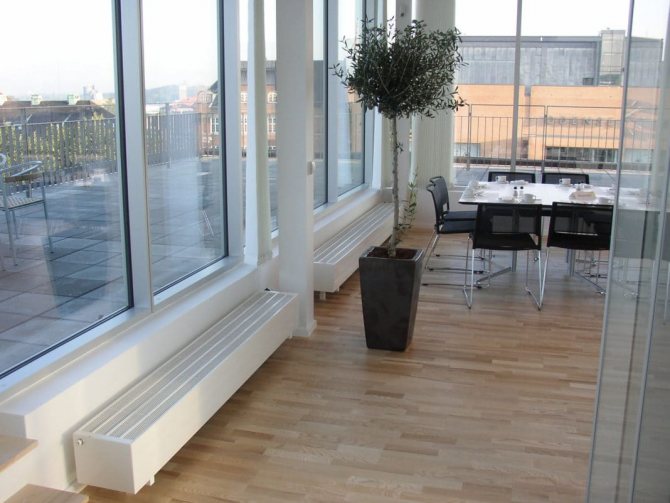

Using convectors in large rooms
According to this method, a room with an area of 20 square meters and a height of 2.7 meters requires 2.16 kW of heat for heating, the same room with a ceiling height of three meters - 2.4 kW. With large volumes of rooms and a significant ceiling height, the calculated area power can increase up to 30%.
An example of calculating the heat output of a convector model Breeze
Let's build an example of calculation on several versions of the model using different data on dimensions. The height of the devices is in the range of 80 - 120 mm, the depth is 200 - 380 mm, the length is from 0.8 to 5 m (5000 mm). The convector with dimensions of 200 x 80 mm has a heat transfer from one meter of length 340 W. We multiply the area of the room by 100, thus obtaining the total demand of the room for thermal energy. Divide the result by 340 - as a result, we see what the total length of the convectors should be. This result can be divided by the length of one of the selected products - you will get their number in pieces.
Many owners of country houses, cottages, summer cottages and other real estate built in an area where there is no natural gas, were able to appreciate the convenience of heating. In addition, these devices have proven themselves well as an additional source of heat.
In order for the operation of such devices to bring maximum comfort and minimum costs, it is necessary to carefully approach the issue of choosing the right model. First of all, attention should be paid to calculating the correct power.
Calculation of the power of an electric convector
Power is the most important indicator of a heater, so the calculation should be as accurate as possible. The power of an electric convector and the area of the room are proportional to each other: the larger the area, the higher the power of the heater. For example, an electric convector is capable of efficiently heating an area of 4-6 square meters, and with a capacity of 6-9 square meters, when the area will already reach 9-11 square meters, it will effectively heat approximately 14-16 square meters. m., and a convector with a capacity to cope with heating a room with an area of 24 to 26 sq.m ..
| Convector 0.5 kW | Convector 1.0 kW | Convector 1.5 kW | Convector 2.5 kW |
Taking into account the baseline conditions for calculating the power of the convector
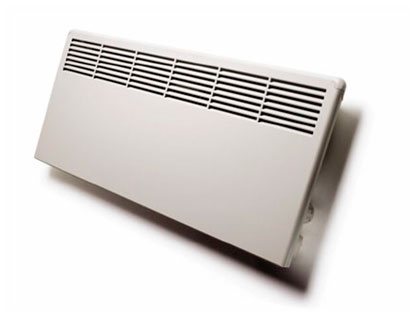

As the main and only source of heating a room, electric convectors can serve in rooms like country houses, summer cottages, offices and commercial buildings, that is, in places that are not equipped with water heating. Ideally, it would be desirable to know the heat loss of the building itself, as well as the presence of insulation in the walls. If these data are not available, the average reference values can be used.
In general, the calculation of the required power of an electric convector for different rooms is carried out according to the following parameters:
- For rooms with high-quality thermal insulation made according to European standards, 20 W per cubic meter of the room is required.
- Medium-insulated objects, in which there are double-glazed windows and insulation using foam, as well as similar methods of insulation, will require 30 W per cubic meter of the room.
- Weakly insulated objects will require even more power - about 40 W per cubic meter. If necessary, this value can be adjusted both up and down.
- Hangars, warehouses and other objects that have practically no insulation will require 50 W per cubic meter, and this may not be enough - everything will depend on the material from which the walls are made.
Please note: these values are given for the case when convectors will be the only method of heating the room.
Universal formula
According to the above indicators, it can be clearly seen that the average level of thermal power is found according to the simple formula “100 W = 1 m 2 of the heated area”. These figures are correct when calculating the power for rooms with a standard ceiling height - from 2.5 to 3 m.In the event that you plan to install the convector in a room with a ceiling height of more than 3 m, it is necessary to apply a correction factor, increasing the required heating power. device by 25-30%. It should be immediately emphasized that this is an average indicator. If the room is cold, has many windows, or a complex shape, then the formula may not work. In this case, our specialists will help you make the right choice.
What is important to consider when using a special program
The calculation program takes into account the nuances of each room where such an electrical device will be installed. These are the features:
- it is important to determine what the device is for. As an additional device for the heating system, or it is better to choose an option when the structure can replace the main heating;
- an important parameter is;
- the more external walls, the more significant the heat loss will be;
- the surfaces on the east and north sides are the coldest;
- the walls on the windward sides are strongly cooled, which is taken into account in the program algorithm;
- when specifying winter temperatures, it is necessary to designate the standard parameters that are characteristic of a certain area in the coldest period of winter. In this case, the program takes into account weather conditions;
- degree of thermal insulation. For example, a brick wall, the thickness of which is 400-500 mm, has average indicators;
- ceiling height is important when calculating the volume of a room;
- important are the premises that are located above and below the room for which the calculations are carried out;
- the type of windows and their thermal insulation characteristics are indicated. The glazing index is also calculated, and the necessary corrections in the calculations are carried out;
- the room may have doors that open to a cool room or even outside. When opening the doors, cold air enters the room. In this case, there will be a large consumption of heat.
The result is reported in kilowatts and watts. According to these parameters, you can evaluate your favorite heater model. In addition to power, it is important to consider parameters such as safety at work, mobility, dimensions and ease of use.
Related article:
In the article, we will consider in detail the design features, how to choose the right heater and the rating of popular models.
One heater - one room
Another important aspect when choosing the power of the convector is the rule “one heater = one room”. Even if you choose a convector with a power of 2,500 W to heat two rooms with an area of, for example, 12 and 14 m 2, its use will not be effective: in the room where you install the convector it will be too hot, and the second simply will not warm up to the required temperature. Therefore, when choosing a convector in terms of power, focus on the largest area of the room in which you will have to operate it.
Water heating, traditional for our country, is complicated and expensive at the installation stage. Therefore, many are looking for other options for heating premises, crowbars, summer cottages and apartments. The first thing that comes to mind is electric heating convectors. Installation is super simple: set it up or hang it up, plug it in. Everything. You can warm up. The only limitation is whether the wiring can withstand such a load. The second is decent electricity bills, but they can be reduced by installing.
Important points when calculating convectors
There is nothing difficult here. First, decide how the convector will be used in general - as the main or auxiliary heating source. And if the convector "alone" heats the house, then its power is determined at the rate of 40 watts / 1 cubic meter. Simply put, 40 watts are required for one cubic meter. How to determine the power of the convector itself? First, the standard dimensions of the room are determined. If these indicators are multiplied, then you can get the area of the room; the resulting figure is multiplied by forty and the value of the required power is obtained.
Note! You should not use a simple calculation formula where 100 is used, not 40. Here you can be quite grossly mistaken, because multiplying by 100, you will not take into account the height of the ceiling. Of course, this plays a special role, but the power of the heater will still be determined incorrectly.
In country houses, as you know, the ceilings are high, which can also affect the heating. With an incorrectly selected formula, the power will be insufficient, and the convector simply will not be efficient enough. In short, consider all possible nuances.


What is convection and convector
Convection is the process of transferring heat through the movement of heated air. A convector is a device that heats air and facilitates its movement. There are convectors in which heating occurs due to the circulation of the coolant, then they are part of the water heating. But we will talk about electric convectors, which convert electricity into heat, and air currents carry this heat around the room.
According to the method of installation, convector electric heaters can be wall-mounted, floor-standing, trenchless (built-in below floor level), baseboard and universal (mounted on the legs that come with the kit or hung on the wall).
It is impossible to say which form of electric convectors is better. All forms are developed taking into account thermodynamics (in any case, normal companies do it this way), so the choice is based only on your own preferences and on which design fits best into the design of the room. Nobody forbids putting different types of electric convectors in one apartment, house or even in a room. The main thing is that the wiring withstands.
Arrangement of electric convectors for heating
The device of the electric convector is simple:
- a housing in which there are openings for air intake and exhaust;
- heating element;
- sensors and control and monitoring device.
The body is made of heat-resistant plastic. The shape can be flat or convex, rectangular or square. There are holes in the bottom of the case - cold air is sucked into them. There are also holes in the upper part of the case. Heated air comes out of them.The air moves without stopping, and the room heats up.
The heating element of an electric convector is what you need to pay attention to when choosing. The type of heater affects the service life of the equipment and the air condition.
Types of heating elements for electric convectors
Heating elements in electric heating convectors are of three types:
Electric convectors with monolithic heaters are considered the best, but they are also the most expensive. With the use of heating elements - a little cheaper.
Types of thermostats and controls
Electric heating convectors can be controlled by a mechanical thermostat or electronics. The cheapest convector electric heaters have a thermostat, which, when the set temperature is reached, breaks the power supply circuit of the heating element. When it cools down, the contact appears again, the heater turns on. Devices of this type cannot maintain a constant room temperature - the thermostat is triggered by the heating of the contact plate, and not by the air temperature. But they are simple and quite reliable.
Electronic control uses several sensors that monitor the state of the air in the room, the degree of heating of the device itself. The data is processed by a microprocessor, which adjusts the operation of the heater. The desired mode is set from the control panel located on the body, and there are also models with a control panel. You can find programmable models that allow you to set the heating mode for a whole week - while there is no one at home, set it to maintain about + 10 ° C or lower and save on bills, before people arrive, warm the room to a comfortable temperature. There are generally “smart” models that can be integrated into the “smart home” system and controlled from a computer.
How to calculate the power of the heater
The calculation of the power of the heating element, necessary to maintain a given temperature in a particular room, is considered in clause 1 of the "Reference data".
To verify that the marking data matches the real parameters
TEN need to check its resistance with an ohmmeter while hot. In this case, you can neglect the various coefficients. P = U * U / Rwhere P - the power to be found, W; U - operating voltage, V; R - the measured resistance of the heating element in a hot state, Ohm. For example: The voltage in the network is 220 volts, the measured resistance is 22 ohms. Then the power of the heating element matters: P = 220 * 220/22 = 2200 W = 2.2 kW.
To calculate the time for which the heating element will heat the water, we use the thermodynamics formula.
In this case, for simplicity, we will assume that the environment, transients, capacity, etc. do not affect our heating element system - liquid: A = C (T1-T2) mwhere BUT - the work that needs to be done to change the temperature of the liquid of mass "m" from T1 to T2. FROM - specific heat capacity of the liquid; and the formula for the work of electric current: A = Ptwhere BUT - work of electric current, R - installation power (in our case - heating elements), W, t - operating time of electric current, sec. Example: How long will it take for a 2.0 kW heater to heat water with a mass of 1.0 kg. from 20 to 80 degrees? Reference data: C for water = 4200 J / kg * degree. C (T1-T2) m = Pt, hence t = C (T1-T2) m / P = 4200 * (80-20) * 1.0 / 2000 = 126 seconds. Answer: water weighing 1.0 kg will be heated by a heating element with a power of 2 kW from 20 to 80 degrees in 2 minutes and 6 seconds.
3. Selection of a heating device with optimal power.
The power of the heater determines its ability to maintain a certain temperature in the room. The second quantity on which it depends is the volume of the room. At the same time, there is one condition - the thermal insulation of the room must be acceptable for the given climatic zone. For a standard height of residential premises in Russia of 2.2-2.5 meters, the ratio of power to area is 1:10, i.e. a 1 kW heater can heat a room of 10 sq. meters. If the height of the room exceeds the above value, then a correction factor must be used.For example, if the height of the room is 3 meters, then: K = 3 meters / 2.5 meters = 1.2. Those. in this case, the ratio of the power of the device and the heated area will be 1.2 kW: 10 square meters.
Dependence of the volume of the coolant (liquid) of the heating system on power.
An approximate calculation of the volume of the heating system coolant can be made using the following ratio: for a heating system with a 1 kW boiler, 15 liters of coolant are required. Accordingly, the volume of a heating system with a 10 kW boiler will be approximately 150 liters. + The data obtained with such a calculation of the volume of the coolant in the heating system does not take into account the characteristics of a particular heating system and are only approximate
Choosing a location
Rather, the question is not: which of the convectors is suitable for fulfilling your wishes. If you want to bring the appearance of the room closer to the standard one, you can hang rectangular wall convectors under the windows. A little more attention is attracted by models that can be installed under the ceiling, but they are not accessible to children and pets - they will not be able to burn themselves or "adjust" in their own way. The installation method is the same here - on brackets fixed to the wall. Only the shape of the brackets differs.
If you want the heating devices to be invisible, you will have to choose between baseboard models and trench models. There is a big difference in installation: the skirting boards were simply installed and plugged into the network, while under the floor ones you will have to make special recesses in the floor - their top panel should be on the same level with the finished floor.
Power calculation
If the convector is needed only as an additional source of heat - for the period of severe cold weather - it makes sense to take a couple of low-power devices - 1-1.5 kW each. They can be rearranged in those rooms where it is required to raise the temperature. If convector heating is the only source of heat, everything is much more serious.
If you do everything "according to your mind", you need to calculate the heat loss of a house or apartment and select equipment based on the results of the calculation. In fact, this is done very rarely. Much more often they consider the required heating power by area: for heating 10 sq. m. area requires 12 kW of heat. But these are the norms for the average ceiling height - 2.50-2.70 m and average insulation. If the ceilings are higher (you need to heat the air volume) or there is absolutely no insulation, the power is increased by 20-30%.
How to calculate the power of a heating convector by area or heat calculation of a room?!
Convectors are the main heating devices for heating residential, public premises and industries. Most often, when installing high-quality internal heating, the choice falls on convectors, since they provide a highly efficient and uninterrupted heat source capable of heating rooms of any purpose and size.
An important factor after choosing the type of convector is the calculation of its power.
Consider 2 options for calculating the power (W) of the convector
The selection is based on the area of the room.
This option for calculating the power of the convector is not correct (explanation at the end of the section), but it is often used and therefore we will consider it too.
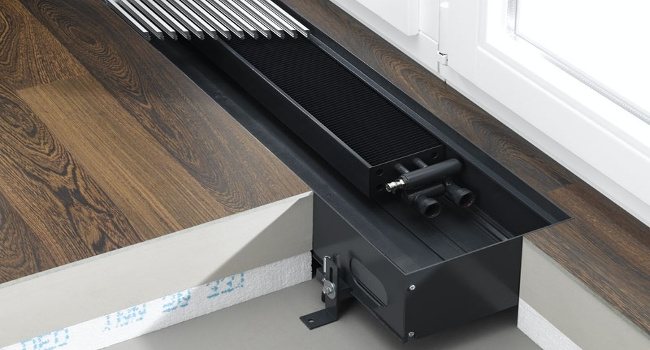

Required data for calculation
To make calculations, you will need to collect the necessary data, on which the correctness of the results will depend.
What determines the calculation of the power of the convector
Calculating the optimal power indicator of a heating device for a home is not an easy task. In this case, it is important not to be lazy to make calculations and manipulate numbers, because only this will help determine the golden mean for your room. Too large an indicator of the device becomes the main reason for high cash costs, the lack, in turn, leads to the lack of the required amount of heat.
When independently calculating the power of the heater, the following factors must be taken into account:
- convector type;
- location of the room (corner, built-in);
- the number of windows in the room;
- ceiling height;
- the presence of a different type of heating;
- number of exterior walls;
- the presence of thermal insulation, type of glazing.
To avoid errors in the calculation, it is important to take into account all the details of the location of the room. It is preferable to seek professional help, but if this is not possible, you can do it on your own, relying on the basic calculation methods.
Power calculation formula
The calculation of power by area is the simplest, since it requires minimal knowledge. The standard formula for such a calculation says that for heating 10 sq.m. area, 1 kW of thermal energy is required as standard. But this formula is not perfect and should not become a template. Even in the standards, there are exceptions and shortcomings.
Exceptions for which the thermal energy coefficient may change include:
- angular arrangement of the room - 1.2 kW;
- no external wall insulation - 1.1 kW;
- single-pane glass windows - 0.9 kW;
- high ceilings (from 2.8 to 3 m) - 1.05 kW;
- high-quality thermal insulation, triple glass unit - 0.8 kW.
Ideally, the calculation takes into account such details as the presence of an entrance door, a wind rose, as well as the optimal ratio of the area of flooring and windows. From this it follows that the optimal power indicator for a built-in room is 20 sq. M. with standard heat losses, a ceiling height of 2.7 m and a single glass unit is 2 kW.
Simple calculation table
To determine the optimal power of the convector, you can use the universal table of capacities by the area of the heated room, taking into account the height of the ceilings and important placement factors:
| room area | power in kW taking into account: | ||||
| ceiling height 2.7 m | ceiling height 2.8 m | ceiling height 2.9 m and more | 1 outer wall | 2 external walls | |
| 10 | 1 | 1,12 | 1,16 — 1,2 | 1kw | 1,2kw |
| 15 | 1,5 | 1,68 | 1,74 — 1,8 | 1,2kw | 1,3kw |
| 20 | 2 | 2,24 | 2,32 — 2,4 | +10% | +10% |
| 25 | 2,5 | 2,8 | 2,9 — 3 | +15% | +15% |
| 30 | 3 | 3,36 | 3,48 — 3,6 | +20% | +20% |
Using the table above, you can easily select the required power for the convector. When placing a room in a corner, it is important to apply a multiplying factor of 1.1 to the parameters presented, if there is reliable thermal insulation in the room - 0.8.
So, the description of this method from a scientific point of view:
The calculation of the power by the area of the room is applicable, but !!! This method was used earlier and is used now, only in the construction of a district, microdistrict, mini-towns, etc., in a certain region. It is used to determine the capacity of a district boiler house or ITP.
When construction is underway from the same type of material and the volume of construction is determined, they take 1 house, perform heat calculation and remove heat loss per 1 sq.m.
For individual or private construction, this method is not applicable, since all buildings are made of different materials.
Using this method, you will never determine how much heat needs to be supplied to the room to heat it. You will either overpay for heating, there will be excess heat, or it will be cold in the winter in the house or apartment.
Selection of convectors using heat engineering calculation of external fences.
At first glance, this method seems complicated, but in fact, you do not need to puzzle over it.
When you purchase a convector or other device for heating, you just need to check with the seller the following: What power does this or that device give (W) and at what temperature of the coolant (for water heating systems)?
If it is possible to obtain such information, then it is good and you can continue the dialogue further, if they cannot say, then it is better to contact another place to purchase a heating device.
So, suppose you have received an answer to the question and what to do next ?:
- You need to have on hand a plan or project with the dimensions of the rooms and windows;
- To find out the temperature of the coolant in your heating system, for apartments, this is provided by the management company, for private houses, when buying a heating boiler, in its technical characteristics there is such information.
Consider the option with apartments, since a private house requires a more professional approach in the field of heat and power engineering.
You just need to find out what the outer walls in the apartment are made of. A management company or a builder with whom you will make repairs will help you in this matter.
There are several types in modern construction, exterior walls in multi-storey buildings:
- The wall material is homogeneous;
- Multilayer with insulation;
- Ventilated facade;
- Glass.
With this information, you can contact the same company where you are going to purchase a heating device and ask to make a selection taking into account the above data.
If they could not help you for some reason, then do not get upset, not all sellers in the field of heating understand this issue, it is better to contact where there are professionals.
When you managed to find a common language with the seller or engineer, you can safely buy a convector or other heating device.
This method guarantees 95-100% that you bought a heating device that suits you and did not overpay 2-3 times.
Manufacturers, characteristics and prices
Electric convector heaters are produced by several companies that produce other household appliances - Electrolux, AEG, Hyundai, Stiebel Eltron, Zanussi. In addition, there are many firms that specialize in just such a technique or produce two or three more groups of goods. Among them are Russian manufacturers - Ballu, Termica, Ural-Mikma-Term, Elvin. There is also a whole group of European brands:
- Airele, Noirot and Atlantic (France),
- Extra, Royal Thermo, Scoole, Timberk, WWQ (China),
- Frico (Sweden),
- NeoClima (Greece),
- Nobo (Norway)
and many others. Electric heating in Europe is the norm, they rarely have water heating. Hence the number of firms engaged in the production of such household appliances. But, as usual in recent years, most firms have moved production to China, so the assembly is mostly Chinese, although quality control should be at the level.
Electric heating convectors can be from 0.5 kW to 2.5-3 kW. They work mainly from a 220 V network, if necessary, you can find three-phase ones - from 380 V. With an increase in power, the size (mainly depth) and price grow. If we talk about prices on average, then for imported electric convectors the price is about $ 80-250, for Russian ones - $ 30-85.
| Name | Power | Additional functions | Mounting type | Control type | Heating element type | Dimensions (D * W * H) | Price |
| AEG WKL | 0.5 / 1 / 1.5 / 2 / 2.5 / 3 kW | overheat protection | Wall | Thermostat | Heating element | 78*370*450 | 105 — 195 $ |
| Airelec Paris digital 05DG | 0.5kw | overheat protection | Wall | Electronic | Monolithic | 80*440*400 | 60-95 $ |
| Termica CE 1000 MR | 1 kW | Overheating protection + ionizer | Floor | Thermostat (mechanical) | Heating element | 78*400*460 | 50 $ |
| Nobo C4F 15 XSC | 1.5 kW | Wall / floor | Electronic | Heating element | 55*400*975 | 170 $ | |
| Stiebel Eltron CS 20 L | 2 kW | Overheating protection + fan | Floor | Thermostat (mechanical) | spiral heating element | 100*437*600 | 200-220 $ |
| Stiebel Eltron CON 20 S | 2 kW | overheat protection | Floor | Thermostat (mechanical) | Heating element made of stainless steel | 123*460*740 | 450 $ |
| Noirot Melodie Evolution1500 | 1.5 kW | Overheat and rollover shutdown | Wall-mounted (low height) | Electronic | Monolithic | 80*220*1300 | 300-350 $ |
| Ballu BEC / EVE - 1500 | 1.5 kW | Overheat and rollover shutdown | Wall / floor | Electronic | Heating element Double G Force | 111*640*413 | 70 $ |
| Timberk TEC.PF1 M 1000 IN | 1 kW | Overheat and rollover shutdown + ionizer | Wall / floor | Thermostat (mechanical) | 100*410*460 | 65 $ | |
| Dantex SD4-10 | 1 kW | Overheat and rollover shutdown | Wall / floor | Electronic | Needle + Quiet + Economical | 78*640*400 | 45 $ |
Useful additional functions
When choosing electric convectors for heating, pay attention not only to technical parameters. There are also additional features that increase comfort and safety:
Overheating protection and fall-off are very useful features to enhance the safety of your equipment. What else you can pay attention to is how quiet or loud the unit is. It's not just about the heating element (he usually clicks). When triggered, the mechanical thermostat also clicks. If you choose convection heaters for your bedroom, quiet operation is very important.



